Content
- 1 Bavaria
- 2 Bonita
- 3 G.F. Wilson
- 4 Candy Stripes
- 5 Nettleton Variation
- 6 Scarlett flame
- 7 White Delight
- 8 Amazing Grace
- 9 Emerald Cush Blue
- 10 Varieties
- 11 Cultivation and care of subulate phlox
- 12 Reproduction
- 13 Diseases and pests
- 14 Combination with other plants
- 15 Application in landscape design
- 16 Description
- 17 Varieties
- 18 Possible breeding methods
- 19 Planting phlox subulate
- 20 Care
- 21 Disease and pest control
- 22 The use of subulate phlox in decorating the site
- 23 Phlox subulate, varieties:
If you are looking for a spectacular yet easy-to-care plant for rockeries, alpine slides or curbs, you are in luck! Here's our personal top of the most delicious styloid phlox strains.
Subulate phloxes are a real dream of a florist. They form a thick bright carpet, do not "be capricious" and hardly get sick. Take note of the list of the 9 most beautiful varieties of this wonderful plant.
Bavaria
Bavaria is a variety of phlox with an unusual elegant color. The flowers of this plant are two-colored: white petals at the base are colored with violet "rays".
These phlox bloom twice - in late spring - early summer and late summer - early fall. True, the second bloom is more scarce.
| Petal color | Bush height (cm) | Bush diameter (cm) | Flowering time |
| White, purple at the base | 15 | 50 | May-June, August-September |
Bonita
Bonita bushes cover the flower bed with such a lush carpet of flowers that in a few years they can turn your front garden into a real lavender sea. The flowers of this phlox have a pleasant pink tint, the plant has excellent winter hardiness and unpretentiousness in growing.
| Petal color | Bush height (cm) | Bush diameter (cm) | Flowering time |
| Hot pink with a dark pink spot at the base |
5-15 |
30-50 |
May June |
G.F. Wilson
Wilson phlox is one of the easiest to care for among the styloid flowers. It grows quickly and easily, forming a pillow up to 20 cm high. Its flowers have a delicate lilac shade.
Phlox are great for creating mixborders and combine perfectly with daffodils, irises and other crops that bloom in May.
| Petal color | Bush height (cm) | Bush diameter (cm) | Flowering time |
| Lilac with purple spots at the base |
10-20 |
30-60 |
May June |
Candy Stripes
Phlox Candy Stripes flowers resemble beautiful lollipops: the petals are painted with white-pink stripes and specks of fuchsia. This handsome man does not require special care, he can endure even the most severe frosts. It is enough to plant it on the southwestern side of the site, water it moderately and feed it periodically.
| Petal color | Bush height (cm) | Bush diameter (cm) | Flowering time |
|
White with pink stripes and a purple spot at the base |
10-15 |
May June |
|
Nettleton Variation
This variety is good not only for its rich pink flowers, but also for its beautiful, "mint" shade, foliage. The bushes will adorn a curb, alpine slide or flower garden even after flowering ends.
| Petal color | Bush height (cm) | Bush diameter (cm) | Flowering time |
|
Lavender |
5-10 |
30-45 |
May June |
Scarlett Flame
During flowering, the bushes of this subulate phlox are covered with rather large flowers with a diameter of about 2 cm. The name of the variety translates as "scarlet glow", but the flowers of Scarlett Flame are rather dark pink.
Of the special requirements of these phloxes for care, only sufficient lighting (sun or partial shade) and high water permeability of the soil can be distinguished - subulate phloxes do not react well to waterlogging.
| Petal color | Bush height (cm) | Bush diameter (cm) | Flowering time |
|
Dark pink |
10-15 |
40-60 |
May-June, August-September |
White Delight
White Delight is a snow-white subulate phlox that will decorate borders, rockeries and alpine slides in your garden with its flowering for 3-4 weeks in late spring - early summer. Like other phloxes of this species, it is not picky about soil acidity and care, but prefers sunny areas.
| Petal color | Bush height (cm) | Bush diameter (cm) | Flowering time |
|
Snow white |
10-15 |
30-50 |
May-June, August-September |
Amazing Grace
Bushes of the Amazing Grace variety ("Amazing Grace" - in honor of the famous English church anthem) are slightly inferior in size to other phloxes of this species, but they do not lose in beauty to them. The flowers of this perennial have a characteristic color: white petals with a crimson ring around the center.
| Petal color | Bush height (cm) | Bush diameter (cm) | Flowering time |
|
White with a crimson ring at the base |
5-15 |
30-45 |
May-June, August-September |
Emerald Cush Blue
Small (about 1.5 cm) purple flowers of this variety of phlox bloom on an emerald green cushion of leaves. The size of an adult Emerald Cush Blue bush is about 15 × 60 cm.
This variety will grow in any type of soil, but only grows really wildly on well-drained sandy soils and in good light.
| Petal color | Bush height (cm) | Bush diameter (cm) | Flowering time |
|
Bluish purple |
10-15 |
Up to 60 |
May-June, August-September |
If you love phlox, you may also be interested in our material about another type of these flowers - Drummond phlox.
Subulate phlox will be an excellent decoration for any garden plot. They are bright, spectacular and absolutely unpretentious. Belongs to the Sinyukhovye family. The subulate phlox is native to North America.
The stem is creeping or erect. The leaves are narrow-oval. The color of the leaves is bright green. Wherein the arrival of winter does not change the color of the leaves... Fragrant flowers form inflorescences. The sizes of the inflorescence are different depending on the variety.
The colors of the flowers are varied: pink, white, red, purple and others.
Varieties
Thanks to breeding work, a huge variety of different plant varieties have been bred.
Carpet lights
This is non-varietal variety culture. This is the name of the plant, because the subulate phlox is a bright and spectacular ground cover, which is lined with a floral carpet. Bright star-shaped flowers look like lights against the backdrop of greenery.
 Carpet lights
Carpet lights
Candy Strips
Candy Stripes is a very popular variety. The flower is white. There is a wide pink border in the center of the petal. Plants form floral and colorful carpets. Plant height no more than 15 cm.
Flowering lasts throughout the summer season. It is likely to bloom again in early autumn.
 Candy Strips
Candy Strips
Esmerald Blue
Esmerald Blue is a cultivar with a height up to 15 cm... The flowers are lavender. Plants form a continuous floral carpet.
 Esmerald blue
Esmerald blue
Abundant flowering lasts throughout the summer.
Purple Beauty
 Purple Beauty
Purple Beauty
Purple Beauty is a spectacular varietal variety with bright purple flowers. The petals are strongly separated. The variety is highly prolific. The plant begins to bloom in May.
Flowering lasts for 2 months.
Mayishne
 Mayishne
Mayishne
Maischnee is another popular variety of subulate phlox. The flowers are small, wheel-shaped. The color of the flowers is snow-white. Plant height does not exceed 10 cm... Flowering lasts from May to June.
Re-flowering in August is possible, but not as abundant as the first.
Cultivation and care of subulate phlox
Subulate is considered a culture easy to grow and unpretentious.
Ground requirements
Subulate phloxes feel much better on poor and dry soil rather than fertile.
On fertile soil, they practically do not please with their bright and fragrant flowers, since the strength of the plant is spent on building up green mass.
The soil must be loose and neutral... Therefore, if the soil in the area is acidic, then it is recommended to add lime to it.
If the soil is too heavy, it is recommended to add sand to it.
 The plant prefers dry soil
The plant prefers dry soil
It is advisable to plant phloxes in the area where perennial crops previously grew - marigolds, calendula.
Plant in the former strawberry growing area Not recommended, since there is a high risk of contamination of the soil with a nematode.
Landing
Planting seedlings is desirable in early springwhen the soil is already warming up, but retains moisture.
How to plant?
- Before planting, you will need to prepare the soil, for this all weeds are removed;
- Rotted compost can be added to the soil;
- It is not recommended to deeply deepen the seedlings, since the styloid phlox has a superficial root system;
- The distance between the seedlings should be not less than 25 cm.
Care after landing
The care includes the following procedures:
- Systematic loosening of the soil;
- Weed removal;
- Regular and moderate watering. The water is used warm, as cold water causes the stems to crackle;
- Pruning wilted inflorescences.
It tolerates frost well in winter.
In the northern regions can be covered phlox subulate. Film can be used as a cover. However, the stems can sprinkle under cover. As a result, the death of the culture is possible. In snowy winters, they can do without shelter.
In summer, plants tolerate drought and temporary drops in temperature well. In drought, watering is required abundantly.
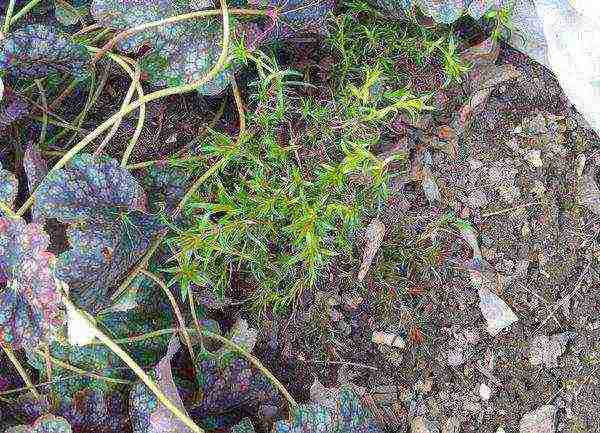 For the winter, subulate phlox is cut from dry flowers.
For the winter, subulate phlox is cut from dry flowers.
Top dressing
At the stage of active growth, it will be necessary to introduce top dressing, which contains nitrogen and potassium... Further, at the flowering stage, you can apply a complex mineral fertilizer.
It is also advisable to add humus. Humus not only stimulates crop growth, but also promotes abundant and intense flowering. It is better to introduce it at the end of the winter period.
Excess fertilizers, especially nitrogen fertilizers, fraught with too little or no flowering.
As a top dressing, you can use wood ash.
Reproduction
Subulate phloxes reproduce in several ways:
- Seed;
- By cuttings;
- By division.
Seeds
Seed propagation is least common method breeding culture. How to propagate subulate phlox using seeds?
- Sow seeds outdoors at the end of February;
- When two true leaves appear on the seedlings, they must be transplanted to the main place of growth;
- The soil where the seedlings grow must always remain moist.
 Seeds of slox subulate
Seeds of slox subulate
Cuttings
- Cut off the apical stalk of the creeping shoot, you can also use the broken off stem;
- Remove lower leaves from the handle;
- Rooting occurs when kept at room temperature in a pot with fertile soil;
- In spring, it can be transplanted into open ground.
By dividing the rhizome
It is desirable to make division in the spring, but it is possible at the end of flowering.
What is required for reproduction by division?
- The plant is dug up;
- The earth is shaken off the earthy coma;
- Each division must have developed roots;
- The resulting plants are planted in pre-prepared holes.
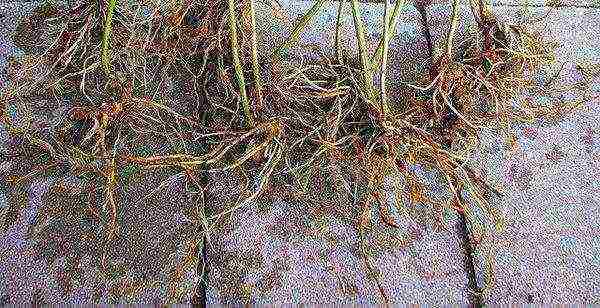 Delenka phlox subulate
Delenka phlox subulate
Diseases and pests
The most common diseases:
- Powdery mildew;
- Variegatedness.
Powdery mildew determined by whitish bloom on the leaves, and variegation manifests itself in the form of ugly patterns on the foliage. It is required to remove the affected parts of the plant.
As a prophylaxis of these diseases, it is required to process the Bordeaux mixture in the spring.
The most common pests:
- Nematode;
- Filamentous worm.
Pests lead to fragility of stems and deformation of leaves... With the development of pests on plants, it is recommended to dig up the plants from the soil and destroy, and treat the soil with nematicides.
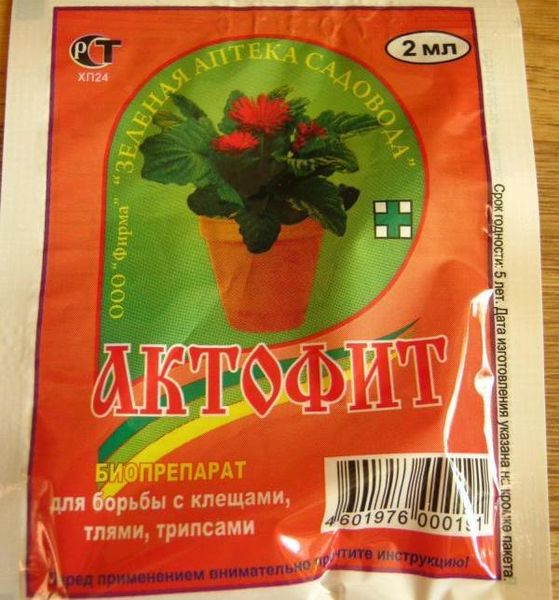 Nematocide for pest control of subulate phlox
Nematocide for pest control of subulate phlox
Combination with other plants
Subulate phlox successfully coexist with such plants:
- Asters;
- Primroses;
- Low-growing irises;
- Poppies;
- Rejuvenated;
- Snapdragon.
Phloxes are also good next to conifers: thuja, juniper, pine.
Application in landscape design
Subulate phlox is good for planting on small lawns, where plants form solid flower carpets.
Phloxes are also used to create low curbs along the garden paths... It is possible to use subulate phlox in rock gardens, rockeries and mixborders.
Especially good flowers in the foreground of flower beds. Also, the culture can be grown in containers that will decorate the verandas, porch or entrance to the garden area.
Thus, the subulate phlox is a bright and unpretentious ground cover that can decorate the garden area, forming a continuous carpet on the lawn. Many varieties are known with a wide variety of colors of flowers-lights.
To create on your site not an ordinary flower garden, but real lakes or a thick carpet of flowers is a very real task if subulate phlox is taken for its implementation.
Description

Phlox subulate / phlox subulata.
Phlox is a plant belonging to the ground cover perennial shrubs of the Sinyukov family.
Basic information about the plant:
- Height: from 15 to 17 cm, there are miniature plants from 5 cm in height, as well as varieties up to 21 cm in height;
- Stem: creeping (lying), green, hard. During the development of the plant, the stem can reach 0.5 m in length. The stem consists of many internodes, which, when in moist soil, often release additional roots. Leaves grow along the entire length on the stems, which are at a short distance from each other.
- Leaves: evergreen, opposite, small (1-2 cm long), narrow, very tough, with a pointed tip. The shape of the leaf, resembling an awl, gave the name to the plant.
- Flowers: small (up to 2 cm in diameter), consist of 5 petals. At the base, they are connected and a tube. When opened, the petals form a flat corolla. The petals are of different colors (white, cream, pink, bright red, blue, etc.), two-color phloxes are often found. During flowering, they exude a delicate aroma.
- Root system: fibrous, consists of many adventitious roots. The depth is up to 15 cm.
- Flowering time: late May - early June. A second flowering period is possible - September.
- Names: The Latin name for phlox subulata is phlox subulata. People also call it creeping, carpet, and also moss carnation.
Varieties
Professional breeders have been practicing subulate phlox for a long time. During this period, they have created many interesting varieties that have become popular among flower growers.
Candy Straps
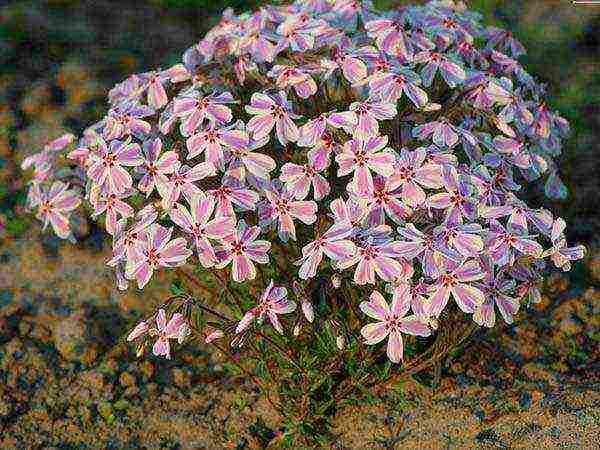
Phlox subulate "Сandy stripes"
The original color of the petals is the main difference between the Candy Straps variety. Their main color is white, it is almost completely covered by a wide strip that has a pink tint. Candy is short, does not rise above 10 cm, blooms profusely, the diameter of the flowers is up to 2 cm. Flowers appear together, Candy blooms for a long time.
Emerald Kushon Blue

Phlox subulate "Emerald cushion blue"
The Emerald Kushon Blue variety has several characteristic differences at once. Firstly, this is the color of the petals: they have a delicate purple color with a bluish tint. Secondly, the abundance of flowering. The flowers of Emerald Kushon Blue are small (up to 15 to 20 mm in diameter), but at the same time there are so many of them that you cannot see green leaves and stems behind a beautiful and dense purple carpet. Thirdly, a bright, noticeable aroma.
Emerald Pink
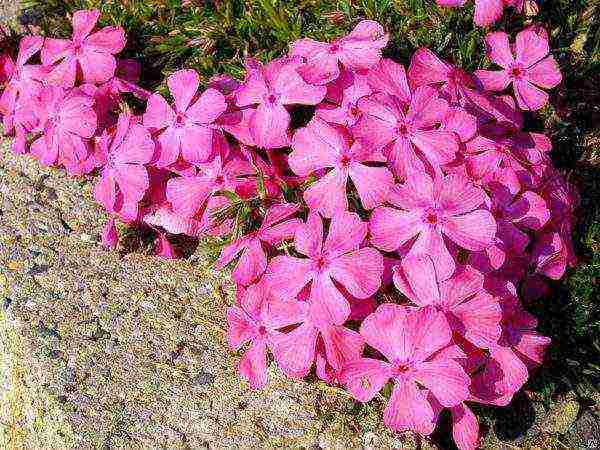
Phlox subulate "Emerald pink"
On any site, the Emerald Pink phlox is always striking - its petals are pinkish with a reddish tint, and the center is highlighted in crimson.
Scarlett Flame

Phlox subulate "Scarlet flame"
The flowers of Scarlett Flame are large enough, up to 2.5 cm in diameter, have a very bright, saturated, even somewhat darkish pink color, which corresponds to its name - "fiery". This shrub has a height of 15 cm, blooms twice: in early summer (May - June) and early autumn (August - September).
Possible breeding methods
To breed subulate phlox, you can use one of three methods.
- Seeds
Using seeds for propagation is not the most common method. This is due to the small number of seeds appearing in the pod after flowering. In one box, on average, there are 2-3 seeds. Usually, the shrub itself uses seed propagation, when new plants appear with the help of self-sowing seeds.
If the gardener managed to collect or purchase seeds, they need to be planted in a container in the fall. A small flat container is filled with a mixture of soil, humus, sand. The seed pods are placed shallowly (1.5 cm) and the container is left in a cool place (cellar, balcony). To create natural conditions, they cover with snow before the new year. During the winter, the sprouts germinate, in early spring (March) they can be planted in a greenhouse, and in April they will be planted in a permanent place in the ground.
- By dividing the bush
Often only on personal plots used for reproduction, the division of the bushes is used. Thus, it is possible to increase the planting of a particular variety of a certain color range. The bushes can be divided in April. The procedure is easy, for this you need to pick up a well-grown bush.
- The bush chosen for dividing is carefully dug out.
- The dug out bush is divided into parts so that each has roots.
- The parts separated from the bush are planted in the designated place.
- Cuttings
In spring (early April) and summer (after flowering), you can use another method of reproduction of subulate phlox - cuttings. The semi-shrub has a high survival rate, therefore, it does not require complex actions or special preparation for cuttings.
Any escape can become a cutting. It is desirable that it has several roots from the internode, but their absence will not hurt: the cutting itself will take root.
Cuttings can also be those parts of the shoots that were broken off when dividing the bush.
- Rooting pinned shoots
Several new plants can be obtained from the growing stems of phlox. This is facilitated by the rapid emergence of roots on those parts of the stem, which turned out to be lying directly on wet ground. This feature is used for reproduction. The selected stem is laid on the ground and sprinkled with soil in the place that will become the center of the new bush. After rooting, the new shrub is cut off from the old plant.
Video "Spring phlox - subulate phlox"
Planting phlox subulate
Phlox are one of the most convenient plants for flower growers. They are unpretentious, take root well, do not require special care. But certain rules for planting and caring for a plant must be followed in order to achieve its lush flowering.
Seat selection
For all its undemandingness, the styloid phlox has its own preferences for the landing site. The plant thrives best in sunny places with well-drained soil. If the plant is planted in areas with heavy soil, it must be diluted with sand.
In partial shade, you can also achieve good flowering, but care must be taken that the soil is not excessively wet: phlox suffers in wetlands, in areas with high humidity.
Poor or stony soil will not cause problems for the plant, phlox will easily master it and cover it with a beautiful carpet. The plant develops better on neutral soils.
Landing
Before planting, a planting pit is prepared for the shrub. The order of its filling: drainage (expanded clay, pebbles), a mixture of soil with humus and a small amount of ash.Seedlings, cuttings or parts of a bush are dipped in Kornevin's solution, after which they are planted at a distance of 30 cm from each other, so that each bush has room for stems that will soon appear.
When planting in early spring, when the soil is still wet, additional watering of the planted plants is not required. If the cuttings are planted later, when the soil has already become dry, it is moistened around the planted cuttings. In this case, you need to be careful not to overfill the cutting. The planted cuttings are covered with a non-woven cloth and left for several days (up to 1 week) for the cuttings to take root.
Care

Phlox subulate grade "Aurora"
The cultivation and care of subulate phlox includes traditional procedures.
Watering
Moderation when watering is one of the conditions for the successful development of a plant. The beautiful shrub is hardy and can withstand short dry periods. Excessive moisture becomes more problematic for the plant, it can lead to decay of the roots and plant diseases.
Therefore, the flowers are watered sparingly, after the topsoil dries up. In a dry summer, watering is carried out once every 2-3 days, the rest of the time it is enough to water the subulate phlox once a week.
Weeding
Growing and caring for a decorative dwarf shrub is not complete without systematic weeding. The soil is cleared of weeds before planting, trying to remove the roots in it from the soil mixture. In the future, the plant is weeded regularly.
Top dressing
During the season, you need to carry out several dressings of phlox. This will prolong flowering, make the plant strong and hardy.
Most often, gardeners feed the plant with liquid manure, a small amount (25 g) is diluted in 10 liters of water. You can also use mineral fertilizers.
| FEEDING | TERM | WHAT TO FEED |
| First feeding | before flowering (end of April) | diluted manure or fertilizers based on nitrogen and potassium. |
| Second feeding | June | manure solution with the addition of superphosphate |
| Third feeding | end of july | ash solution (ash (300 g), hot water (2 l) is boiled for 7-10 minutes. After the solution has completely cooled down, water the plants with it). Instead of an ash solution, you can use a phosphorus-potassium supplement. |
Pruning
In the spring, you can prune the plant. This will form a beautiful bush. When pruning at other times (summer, autumn), the buds on the shoots are removed, which leads to problems next year.
Timely removal of corollas, which have faded and dried up, provides a second flowering (August - September).
Video "Phlox subulate - planting, care and reproduction"
Disease and pest control
Subulate phlox is a fairly strong plant that is resistant to many diseases.
Most often, help is required for shrubs that show signs of powdery mildew (lethargy, slow development, decreased flowering). With this fungal disease, it is necessary to start an urgent fight. To stop its development, not only diseased plants are removed from the plantings, but also the topsoil where they grew. After that, the soil and the remaining flowers are treated with any antifungal drug.
To prevent the appearance of powdery mildew, it is possible in the spring, before flowering, to carry out preventive treatment of plantings. To do this, use Bordeaux liquid, and also carry out the treatment with "Topaz" before and after flowering.
Spider mites are pests of the plant. Spots first appear on the leaves, then the entire leaf dries out. Caterpillars often attack stems, and nematodes are another pest. When pests appear, it is necessary to remove the damaged plants and treat the remaining plantings with special preparations ("Actrophyt", etc.).
The use of subulate phlox in decorating the site
The beautiful shrub has found wide application in garden design. It is often used to create beautiful alpine slides or vibrant lawns.Given the plant's low growth, it looks good as a border that adorns garden paths or grows between the tiles of the path.
Phlox is appropriate in flower beds and flowerpots, in single plantings, in combination with other flowers (sedum, snapdragon, bell) or cereals.
Phlox subulate on the site - this is beauty for many years!
Phlox subulate beautiful evergreen ground cover perennial decorative always. Even under the snow, it retains its dark green needle-like leaves that resemble conifers. And when it blooms completely covered with flowers like a veil, then this beauty takes your breath away. Besides varieties of phlox subulate with different colors of flowers created a great variety. And all this riot of colors lasts for a month and even more. And at the end of the season phlox will delight you with re-flowering. although not so abundant.
This perennial is very good planted with a wide border in one color scheme or in a mixture of colors. It is also great for use on retaining walls or in large rock gardens, near stairs and on slopes.
The subulate phlox is a wonderful companion to the beautiful rose, decorating its foot during the spring awakening. It also looks great with sage and catnip, cuff and anaphalis, onions and cereals.
Phlox subulate(Phlox subulata) is an evergreen perennial up to 20 cm tall. Leaves are hard, dark green subulate, up to 2 cm long. Flowers are about 2.5 cm in diameter, collected in small inflorescences at the ends of the stems. Coloring depends on the variety, since in culture only varieties of phlox subulate... It blooms from mid-May for a month, then, under favorable weather conditions, in September.
Phlox subulate, varieties:
Bavaria
»
"Bavaria" - the height of the variety is up to 15 cm, flowers are about 1.8 cm in diameter, snow-white with a blue center.
Candy Stripes
»
"Candy Stripes" - height about 10 cm, flowers up to 2 cm in diameter, pink with a white edge and a purple center.
"Emerald Cashion Blue
»
"Emerald Cushion Blue" ("Emerald Cushion Blue") - a plant about 15 cm tall, blue flowers with a blue ring in the middle.
"Netleton Variation
»
Nettleton Variation is an ornamental foliage variety. The leaves are green with a white-pink border. The flowers are pink up to 1.7 cm in diameter.

"Purple Beauty
»
"Purple Beauty" - the height of the variety is about 15 cm, flowers up to 2.5 cm in diameter are purple-violet with a blue-violet center.
Red Wings
»
"Red Wings" ("Red Wings") - a plant up to 10 cm tall, flowers up to 2 cm, crimson-red with a red eye.
"Ronsdorfer Sean
»
"Ronsdorfer Schone" - salmon-pink flowers with a purple-red eye up to 2 cm in diameter.
"Samson
»
"Samson" ("Samson") - the height of the variety is up to 12 cm, the flowers are deep pink with a bright pink center with a diameter of about 2.2 cm.
"Snowflake
»
"Snowflake" - plant height about 10 cm, snow-white flowers.
"Temiskaming
»
"Temiskaming" ("Temiscaming") - a plant about 15 cm tall, flowers up to 2 cm in diameter, dark purple-crimson.
Location:
Phlox subulateblooms well only in the sun.
The soil can be any, except clay, dry. The plant does not tolerate waterlogging !!!
Care:
In the spring phlox can be fed with mineral fertilizer. But it is better not to get carried away with top dressing, since due to overfeeding the plant grows well, but blooms poorly.
Winter-hardy, but in years with a lot of snow, it can vomit. Although after that it is restored within a year.


